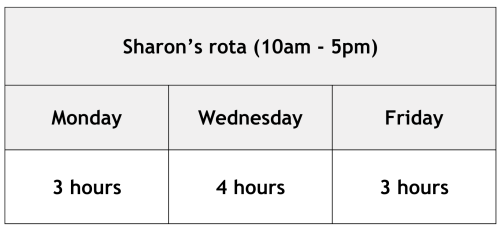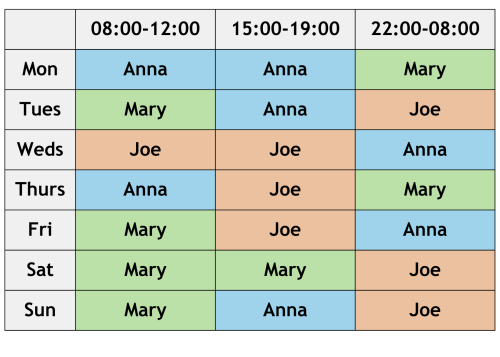Introduction
Putting together an effective and workable staff rota will enable you to organise your Personal Assistants (PAs) in a way which best supports your lifestyle.
The aim of a staff rota is to ensure you have a good balance between flexibility for you and practicality for your PAs.
Constructing your staff rota
When you are putting together a staff rota you need to think about the following things:
- How many hours per week can your budget afford?
- How many PAs do you want to employ? Fewer who work longer hours or more who work shorter hours?
- What days of the week and times of day do you need your PAs to work? Are you flexible or do you need them to work at specific times?
- When are your PAs available to work? Are they only available at fixed times or are they flexible?
Once you are clear about what best suits your lifestyle and what your PAs are practically able to do you can draw up your staff rota.
How many PAs should I employ?
The key question to consider here is:
How many PAs do you want to employ? Fewer who work longer hours or more who work shorter hours?
Employing more PAs for fewer hours each may be financially beneficial as you may pay less in employer’s National Insurance contributions. However, you may pay more in payroll service and training costs. It is best to think purely from a lifestyle rather than a financial point of view when considering this.
Too few hours per PA will mean that each will earn a low income and they may not want the job. However overly long hours may tire your PAs and could be in breach of health and safety law.
You should consider:
- Do you have enough PAs to cover holidays and sick leave?
- Will the rota be too complicated if you employ a lot of PAs?
- Does the rota fit your lifestyle?
- If you employ more PAs, are you happy with the increased administration (e.g. recruiting, keeping personnel records, organising payroll and keeping timesheets)?
- Will you be able to adequately train this number of PAs?
- Are your PAs able to work these hours?
- Would you prefer to have more PAs because you enjoy the variety or less because you like the stability of building a working relationship with just one or two PAs?
When should my PAs work?
The key question to consider here is:
Are you flexible or do you need your PAs to work at specific times and on specific days?
You need to decide the specific times and days your PAs will work. It is a good idea to group tasks and activities together to provide longer shifts e.g. 2 hours instead of half an hour as PAs prefer longer blocks of work – if they only work 30-minute shifts they are unlikely to earn enough to cover the expense of travelling to you.
For example, if you have physiotherapy on Monday at 10am you might decide that your PA will accompany you to physiotherapy then go shopping with you afterwards.
Shift changeovers should fit with your lifestyle e.g. at a time and location convenient to you. If you need continuity of care, overlapping shift times of about 15 minutes are a good idea if your budget allows. This will mean that if the next PA is unable to come to work then you will have someone there with you while you arrange emergency cover.
If you require PAs 24 hours a day/seven days per week you should break each day up into shifts e.g. day shifts and night shifts.
What is my PAs availability?
The key question to consider here is:
Should my PAs work the same hours each day/week? Are they only available at fixed times or are they flexible?
It is usually unrealistic to expect part time PAs to work different hours each week. Part time PAs may have additional jobs and so will need regular fixed hours. Having a fixed rota will help you keep good PAs for longer and it will make it easier to keep track of when each PA should be working.
If you have full-time or live-in PAs, you may wish to have a more flexible shift pattern. An Independent Lives adviser will be able to provide you with more information about this.
Working time regulations
When you are drawing up your staff rota it is important to remember that your adult PAs have the following key rights:
- a 20-minute rest break if their working day is longer than six hours
- 11 consecutive hours rest in each 24-hour period
- 24 consecutive hours rest in each seven-day period or 48 hours consecutive rest each fortnight
- a limit of an average 48 hours a week on the hours they are required to work
- six weeks’ paid leave per year
- a limit on the normal working hours of night workers to an average of eight hours in any 24-hour period and an entitlement to regular health assessments
These rights are intended to protect your PAs’ health and safety. PAs under the age of 18 have slightly different rights. You can read more about these in:
Factsheet 1.6 Working time regulations
Factsheet 7.3 Employing children and young people
Example staff rotas
Independent Lives has templates for you to use to help create a PA availability chart and a rota.
Employer template 1.5(a) PA availability chart
Live-in PAs
Tina employs two live-in PAs (Iain and Tim). Iain works four days, and Tim works three days (including the weekend). Tina pays the same amount for each shift reflecting the fact that Tim is working a weekend. Tina has included an overlap period of half an hour for shift changes.
If you employ live-in PAs it is very important to ensure that they have the relevant rest periods even though they live in your home. As such you may need to arrange extra cover.
Here Iain and Tim could cover each other’s rest periods because they work different days but both live in.
If you have the same PA working every weekend, you should give them some weekends off, either by swapping shifts with another PA or by making sure they take their holiday entitlement. You might want to have a rotating shift pattern for weekends if you have more than one PA.
One PA working ten hours per week
John employs one PA (Sharon) who works ten hours per week. John does not require assistance first thing in the morning or last thing at night, and he is able to be flexible about when Sharon’s hours are worked on the days specified although he has decided that Sharon should work three to four hours on Monday, Wednesday and Friday at some point between 10am and 5pm.
Three PAs working seven shifts each per week
Julia employs three PAs (Mary, Anna and Joe) and has allocated the shifts equally between them throughout the week. There are 21 shifts, and they work seven shifts each throughout the week. They each have one day in the week where they do not work any shifts at all.



